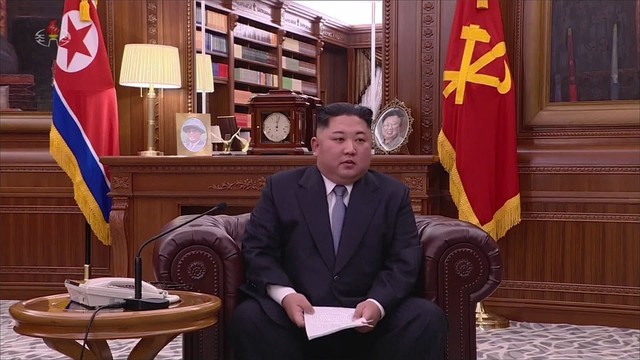Posted on : Jan.3,2019 16:37 KST
Modified on : Jan.3,2019 16:51 KST
 |
|
North Korean leader Kim Jong-un gives his New Year’s address at the Workers’ Party of Korea headquarters in Pyongyang on Jan. 1. (Korean Central News Agency)
|
US President Donald Trump responded to Kim Jong-un’s New Year’s address on Jan. 1 by saying he “look[s] forward to meeting” with the North Korean leader. The message came in answer to Kim saying he was “ready to meet the US President again anytime” and would “make efforts to obtain without fail results which can be welcomed by the international community.”
Now that both leaders have confirmed their intent to meet, many are now watching to see whether North Korea-US denuclearization talks can move past their current deadlock and reach a new plateau.
The New Year’s address from Kim and the immediate positive response from Trump can be an indication that the two leaders plan to address issues in a top-down approach. They also hint at the possibility of the two sides shortly moving in earnest to hold a second bilateral summit. But with little headway made in the negotiation process over the past several months, it remains unclear whether the leaders’ commitment will translate into a second summit happening in short order.
While some are focusing on the parts of Kim’s address where he mentions the possibility of seeking a “new way” if US sanctions and pressure continue, the emphasis of the speech was clearly on resolving the denuclearization issue through dialogue and negotiation. It was also significant in terms of Kim personally delivering a message to the US and international community for the first time stressing his firm commitment to “complete denuclearization.”
His reassurance that he does not intend to test, produce, use, or proliferate nuclear weapons is another positive development, suggesting the possibility of a full-scale nuclear freeze. The “new way” was mentioned as something the North “may be compelled” to do – but that can also be turned around to mean that it is strongly committed to dialogue with the US.
With Kim’s address and Trump’s answer confirming where the two leaders stand, both sides should waste no time proceeding with high-level and working-level talks toward a second summit. At the same time, it is worrying to see the widespread skepticism on North Korea that continues in the US administration despite the leaders’ firm commitment to dialogue. Much of the reason the two sides have been spinning their wheels in negotiations over the past few months is because they are being held back by these skeptical views on the North in and around the administration. The commitment of the two leaders is crucial in quieting the doubters.
North Korea is demanding “corresponding measures” as a precondition for progress in denuclearization, and the question of how that is resolved is likely to be key in future progress with dialogue. The talks will never break out of their impasse if Washington continues insisting on “definite denuclearization measures” without offering its own corresponding measures.
In this sense, this seems like a moment that calls for the South Korean government to actively step in and provide a bridge between the two sides. With Pyongyang and Washington clashing over the matters of denuclearization and corresponding measures, it might help oil up the machinery for progress in their dialogue if Seoul can come up with ideas for getting them on the same page. Kim also sent a letter to Trump, and one approach may be to send a special envoy delegation to the North with the reply to produce a mediation plan.
Please direct comments or questions to [english@hani.co.kr]






